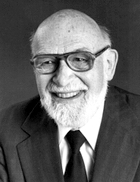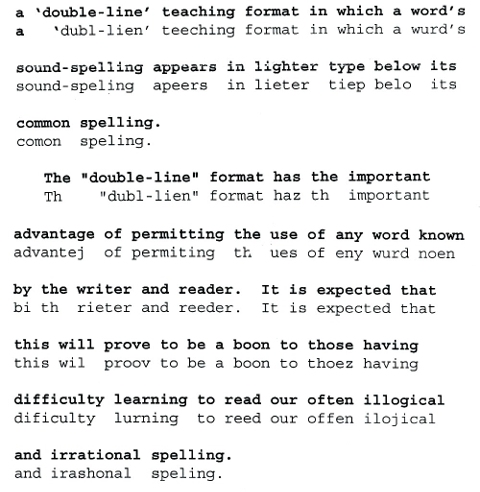
Other Related Pages: Site Map Close This Window
A Brief History of Efforts to Simplify English Spelling
by Dr. Edward Rondthaler
The most comprehensive treatise on the irregularities of English spelling and pre-1970 efforts to correct them are found in Dr. Godfrey Dewey's book "English Spelling, Roadblock to Reading" published by Teachers College Press, Columbia University. It may still be available for $25 from American Literacy Council, 1441 Mariposa Ave. Boulder, CO 80302.
Unlike mathematical principles that remain stable century after century, the pronunciation of words is constantly undergoing change, albeit a very gradual change. But the visual representation of the sound of English words --- their spelling --- has not changed significantly for centuries, so much of our spelling is "out of sync" with sound.
 As a result of radio, telephone and rapid travel, the many regional dialects heard in America in the early 1900s have blended into greater uniformity at the century's end. We are, however, still saddled with essentially the same spelling that appeared in Samuel Johnson's dictionary of 1755. Even then, it was a standard of spelling that didn't accurately represent the sound of spoken words.
As a result of radio, telephone and rapid travel, the many regional dialects heard in America in the early 1900s have blended into greater uniformity at the century's end. We are, however, still saddled with essentially the same spelling that appeared in Samuel Johnson's dictionary of 1755. Even then, it was a standard of spelling that didn't accurately represent the sound of spoken words.
A thousand years ago English was written largely as it sounds. When, in 1066, England fell into Norman hands, French became the language of the English court altho the masses, largely illiterate, continued to speak English during the years of French occupation.
In 1485 William Caxton, a representative of the English king, saw printing in Belgium and Holland, and brought type and a printing press back to England. It is said he assumed that the well educated chancery scribes would become typesetters, but when they saw the disarray of a print shop they refused to abandon their craft of skillful calligraphy for the demeaning task of typesetting. So Caxton imported typesetters from Belgium and Holland.
They were not familiar with English and were merely assembling letters in a language they did not know. British archives show numerous examples of printing in which the Dutch and Belgian typesetters had inserted letters at random to justify lines that would otherwise have been too short.
In the early 1500s a major change in pronunciation known as "the great vowel shift" altered the sound of many English words. The reason for this shift is unknown but, in spite of efforts by John Hart and other scholars of that time, the spoken change was not accompanied by a similar change in spelling.
Samuel Johnson, in 1755, published his scholarly dictionary. It's spellings gave precedence to preserving a word's etymology or origin rather than its sound. Consequently many of the spellings in Johnson's dictionary did not match speech.
Since that time our spelling has remained unchanged except for a few minor simplifications advocated by Ben Franklin and Noah Webster. We continue to beat our heads against the wall. Without rules to tell which English words are spelled as they sound and which are not, every reader and writer of English must faithfully memorize the spelling of every word. Other alphabetically written languages adhere closely to phonic systems and avoid the enormous task of memorizing that baffles many in England and America.
Enter shorthand. Shorthand is based on spoken sound. Shorthand has enticed generations with the possibility of achieving a logical spelling.
The first shorthand was devised by John Willis in 1602. This was followed by more than 200 different systems before Sir Isaac Pitman perfected his "Stenographic Soundhand" in 1837.
Pitman and his son James were major advocates of spelling reform and regarded shorthand as an introduction to it. They collaborated with Alexander Ellis whose aim was to expand our system of digraphs to represents sounds for which we have no single letter --- e.g. sh ng ch etc.
This ultimately led to the notation known initially as "New Spelling" and published in dictionary form by Walter Ripman and William Archer in London in 1941. It is the basis of the American Literacy Council's "SoundSpel", and holds promise of achieving our ultimate goal.
In the United States the first spelling reform effort of record was made by Benjamin Franklin in 1779. He passed the torch along to his younger friend, Noah Webster, who unfortunately did not move it forward to any significant extent.
In 1876 the American Philological Association appointed a committee to study and promote spelling reform. By 1900 a list of over 100 scholars supported the movement. It included F.A.P.Barnard, president of Columbia College; Horace Mann; Francis A. Marsh of Lafayette College; J. Hammond Trumbull and William D. Whitney of Yale; Alexander Melville Bell; Charles Darwin; Frank Laubach; Alfrerd Tennyson; John Greenleaf Whittier, and many others.
The century's early years witnessed much activity. Andrew Carnegie made gifts totaling $260,000 to the Simplified Spelling Board organized in 1906. Theodore Roosevelt expressed strong support for reform. An entering wedge was proposed during his term as president --- tho, altho, thru, thruout, thoro, thorofare, program, catalog, decalog, demagog, pedagog, prolog. It was rejected by Congress but used for White House correspondence. Other lists of recommended words and rules followed and at one point the list respelled 6000 words. By 1909 five hundred publications and 400 universities and normal schools had agreed to use at least a moderate number of simplifications.
An important leader of the movement was Dr. Melvil Dewey, inventor of the Dewey Decimal System and head of the N.Y. State Library Association. In a 1973 meeting between Edward Rondthaler and Melvil Dewey's son Dr. Godfrey Dewey, the latter said that in 1912 his father and some associates built Lake Placid Inn for the specific purpose of attracting teachers on summer vacation during which time they would be indoctrinated with the principles of a rational spelling. It was anticipated that profits from the Inn would provide funds for the advancement of spelling reform.
Basing their work on Alexander Ellis' earlier principle of using the letter e- as a "marker" to indicate that a preceding vowel should be given its "long" pronunciation, Walter Ripman and William Archer, in 1941, compiled a dictionary of 18,000 words in this spelling. It was published in London in 1941.
In the early 1960s Sir James Pitman incorporated Ellis' principles into what he called the "initial teaching alphabet" (i|t|a). In addition to our normal letters it included 16 letter-pairs such as sh, ng, ee, etc. physically linked into ligatures resulting in an alphabet of 42 characters --- which Pitman patented.
Primers using the 42-letter alphabet were published and children, in both England and the U.S., rapidly learned to read them.
The Achilles heel turned out to be Pitman's lack of means for exiting from i|t|a to normal spelling, consequently his endeavor ultimately proved a failure.
In retrospect we see that the physical linkage of letter-pairs into logotypes is unnecessary, and that an exit strategy leading from the logical spelling back into traditional spelling is presently required. ALC's "double-line" format (illustrated below) provides that.
Ellis and Ripman's principle of using an e-marker to denote long vowels has remained valid. It was endorsed, in America, by the Phonemic Spelling Council, an organization chartered in 1971 by the Regents of the State of New York.
Principals of the Phonemic Spelling Council in the 1970-90 period were Dr. Ben D. Wood, inventor of SAT scoring and Director of the Bureau of Collegiate Educational Research, Columbia University; Dr. William Turnbull, president of the Educational Testing Service, Princeton; Dr. Godfrey Dewey, son of Dr. Melvil Dewey mentioned earlier; Dr. Helen Bonnema, professor of Education, Colorado Women's College; Dr. Alvin C. Eurich, president of the Academy for Educational Development, New York; Dr. John Henry Martin, educator and author; Hubert Park Beck, Professor Emeritus of Education, City College of NY; Emmett A. Betts, professor emeritus Miami University; and Abraham F. Citron, Professor of Education, Wayne State University, Detroit.
In 1984 Dr. Edward Rondthaler became a member of the Council and by the end of the decade Joseph Little, a graduate of the University of North Carolina at Chapel Hill, was engaged for the purpose of promoting the Ellis and Ripmam e-marker system under the name "SoundSpel". In 1986 a 44,000-word dictionary in SoundSpel edited by Drs. Edw. Rondthaler and Edw. Lias was published by the Council.
In the early 1990s most of the Phonemic Spelling Council's members had died, and leadership fell into the hands of Edward Rondthaler and Joseph Little who promptly changed the name to the more affable "American Literacy Council" which has been given 501 (c) (3) status by the U.S. Internal Revenue Service.
Currently the e-marker principle is the basis of a new computer program http//www.ententetranslator.com/idl.htm that educators may use as an aid in teaching reading. It has been developed by the American Literacy Council and automatically converts ordinary typing into two lines, the first showing ordinary English spelling and a dimmed line under it showing the spelled in extended phonics. Called Sound-spel, each second line spells words with a consistent notation that non-reading persons can more easily grasp. The translating program that produces this has taken the phonic word lists used in the early grades, and extended them to 14,000 of the most-used English words. A sample of the translated sentences follows.

Double-line does not claim to be a reformed spelling, but it imay be a more effective method of teaching reading or spelling. If phonics is helpful in the early grades, it should be useful for ESL and adult learners as well. While not pressing too hard for reform it will sow seeds of reform that may bear fruit in the future.
When fully implemented it may overcome the hostility that spelling reform has encountered for centuries --- finally bringing the world's most widely spoken language up to par in its written form.